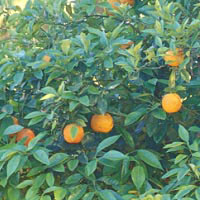health guides
Bitter Orange
 © Martin Wall
© Martin WallParts Used & Where Grown
The dried outer peel of the fruit of bitter orange, with the white pulp layer removed, is used medicinally. The leaves are also commonly used in many folk traditions. The bitter orange tree is indigenous to eastern Africa, Arabia, and Syria, and cultivated in Spain, Italy, and North America.
- Reliable and relatively consistent scientific data showing a substantial health benefit.
- Contradictory, insufficient, or preliminary studies suggesting a health benefit or minimal health benefit.
- For an herb, supported by traditional use but minimal or no scientific evidence. For a supplement, little scientific support.
Our proprietary “Star-Rating” system was developed to help you easily understand the amount of scientific support behind each supplement in relation to a specific health condition. While there is no way to predict whether a vitamin, mineral, or herb will successfully treat or prevent associated health conditions, our unique ratings tell you how well these supplements are understood by the medical community, and whether studies have found them to be effective for other people.
For over a decade, our team has combed through thousands of research articles published in reputable journals. To help you make educated decisions, and to better understand controversial or confusing supplements, our medical experts have digested the science into these three easy-to-follow ratings. We hope this provides you with a helpful resource to make informed decisions towards your health and well-being.
This supplement has been used in connection with the following health conditions:
| Used for | Amount | Why |
|---|---|---|
Indigestion, Heartburn, and Low Stomach Acidity | 3 portions of tea daily, prepared with 1 to 2 grams of dried peel | Bitter orange has traditionally been used as a digestive aid. |
Insomnia | Refer to label instructions | Bitter orange has a history of use as a calming agent and to counteract insomnia. |
Obesity | An amount providing not more than 70 mg of synephrine alone, or not more than 40 mg of synephrine in combination with up to 320 mg of caffeine | Bitter orange contains synephrine, which might promote weight loss.
|
Traditional Use (May Not Be Supported by Scientific Studies)
Bitter orange is used similarly in a wide variety of traditions. In Mexico and South America the leaf is used as a tonic, as a laxative, as a sedative for insomnia, and to calm frazzled nerves.1, 2 The peel of the fruit is used for stomach aches and high blood pressure.3, 4 The Basque people in Europe use the leaves for stomach aches, insomnia, and palpitations and the bitter orange peel as an anti-spasmodic.5 In traditional Chinese medicine, the peel of the immature fruit is used for indigestion, abdominal pain, constipation, and dysenteric diarrhoea. Where the patient is weak, the milder, mature fruit is used similarly.6 Bitter orange continues to be widely used for insomnia and indigestion in many parts of the world.7
Copyright © 2024 TraceGains, Inc. All rights reserved.
Learn more about TraceGains, the company.
The information presented by TraceGains is for informational purposes only. It is based on scientific studies (human, animal, or in vitro), clinical experience, or traditional usage as cited in each article. The results reported may not necessarily occur in all individuals. Self-treatment is not recommended for life-threatening conditions that require medical treatment under a doctor's care. For many of the conditions discussed, treatment with prescription or over the counter medication is also available. Consult your doctor, practitioner, and/or pharmacist for any health problem and before using any supplements or before making any changes in prescribed medications. Information expires December 2024.


 We are proud to announce that
We are proud to announce that  As the market evolves, customers increasingly request a wider variety of omega-3 options for their lipid...
As the market evolves, customers increasingly request a wider variety of omega-3 options for their lipid...  Maintaining healthy glucose levels is crucial for preventing metabolic conditions like diabetes,...
Maintaining healthy glucose levels is crucial for preventing metabolic conditions like diabetes,...  Looking at formulating a new vitamin blend? Discover
Looking at formulating a new vitamin blend? Discover 







































